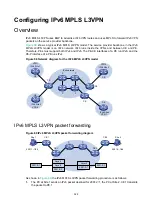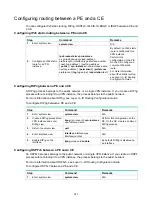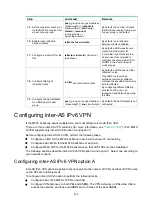
320
Configure OSPF to ensure connectivity between PEs, and configure MP-IBGP to exchange VPNv4
routing information between PEs.
Configure MPLS L3VPN FRR on PE 1 to achieve the following purposes:
•
When the link PE 1—PE 2 operates correctly, traffic from CE 1 to CE 2 goes through the path
CE 1—PE 1—PE 2—CE 2.
•
When BFD detects that the link between PE 1 and PE 2 fails, traffic from CE 1 to CE 2 goes
through the path CE 1—PE 1—CE 2.
Figure 87 Network diagram
Table 28 Interface and IP address assignment
Device Interface
IP address
Device
Interface
IP address
CE 1
Loop0
5.5.5.5/32
CE 2
Loop0
4.4.4.4/32
GE1/1/1 10.2.1.1/24
GE1/1/1 10.1.1.1/24
PE 1
Loop0
1.1.1.1/32
GE1/1/2 10.3.1.1/24
GE1/1/1 10.2.1.2/24
PE
2 Loop0
2.2.2.2/32
GE1/1/2 10.1.1.2/24
GE1/1/2 10.3.1.2/24
GE1/1/3 172.2.1.1/24
GE1/1/3 172.2.1.2/24
Configuration procedure
1.
Configure IP addresses and masks for interfaces as shown in
, and configure BGP and
MPLS L3VPN. (Details not shown.)
For more information about configuring basic MPLS L3VPN, see "
."
2.
Configure MPLS L3VPN FRR on PE 1:
# Configure BFD to test the connectivity of the LSP to 2.2.2.2/32.
<PE1> system-view
[PE1] mpls bfd enable
[PE1] mpls bfd 3.3.3.3 32
# Create routing policy
frr
, and specify the backup next hop as 10.1.1.1 for the route to
4.4.4.4/32.
[PE1] ip prefix-list abc index 10 permit 4.4.4.4 32
[PE1] route-policy frr permit node 10
[PE1-route-policy] if-match ip address prefix-list abc
















































